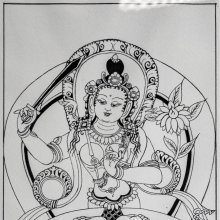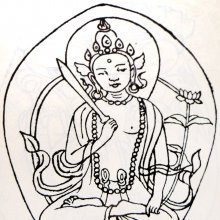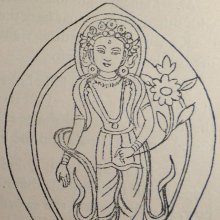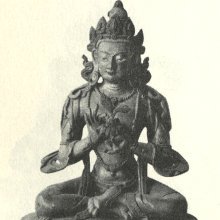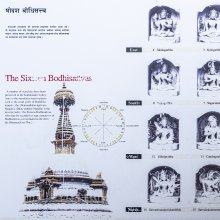Mahasthamaprapta, Mahāsthāmaprāpta: 7 definitions
Introduction:
Mahasthamaprapta means something in Buddhism, Pali, Hinduism, Sanskrit. If you want to know the exact meaning, history, etymology or English translation of this term then check out the descriptions on this page. Add your comment or reference to a book if you want to contribute to this summary article.
Images (photo gallery)
In Buddhism
Mahayana (major branch of Buddhism)
Source: Wisdom Library: Maha Prajnaparamita SastraMahāsthāmaprāpta (महास्थामप्राप्त) is the name of a Bodhisattva who is praised by the Buddhas, according to the 2nd century Mahāprajñāpāramitāśāstra chapter XLVII.—Accordingly, “the Buddhas praise these Bodhisattvas. Who are they? They are, for example, Wen-chou-che-li (Mañjuśrī), P’i-mo-lo-kie (Vimalakīrti), Kouan-che-yin (Avalokiteśvara), Ta-che-tche (Mahāsthāmaprāpta), Pien-ki (Samantabhadra). These leaders among the Bodhisattvas appear in the threefold world (traidhātuka), create for themselves innumerable bodies by transformation, enter into saṃsāra and convert beings. From such exploits (adbhuta) comes the entire very profound prajñāpāramitā”.

Mahayana (महायान, mahāyāna) is a major branch of Buddhism focusing on the path of a Bodhisattva (spiritual aspirants/ enlightened beings). Extant literature is vast and primarely composed in the Sanskrit language. There are many sūtras of which some of the earliest are the various Prajñāpāramitā sūtras.
Tibetan Buddhism (Vajrayana or tantric Buddhism)
Source: archive.org: The Indian Buddhist Iconography1) Mahāsthāmaprāpta (महास्थामप्राप्त) (“one who has obtained great strength”) is the name of a Bodhisattva commonly depicted in Buddhist Iconography, and mentioned in the 11th-century Niṣpannayogāvalī of Mahāpaṇḍita Abhayākara.—his color is white or yellow; his symbol is six lotuses or sword.
Mahāsthāmaprāpta is described in the Niṣpannayogāvalī as follows:—
(1: Mañjuvajra-maṇḍala):—“Mahāsthāmaprāpta is white in colour and holds in his left hand a bunch of six full-blown lotuses, while the right displays the Varada-mudrā”. (2: Dharmadhatūvāgīśvara-maṇḍala):—“Mahāsthāmaprāpta is yellow in colour. He holds the sword in the right hand, and the lotus in the left”.
2) Mahāsthāmaprāpta (महास्थामप्राप्त) or Mahāsthāmaprāptalokeśvara refers to number 106 of the 108 forms of Avalokiteśvara found in the Machhandar Vahal (Kathmanu, Nepal). [Machhandar or Machandar is another name for for Matsyendra.].
Accordingly,—
“Mahāsthāmaprāpta is similar in all respects to Padmapāṇi Lokeśvara (No. 104).—Padmapāṇi Lokeśvara also is similar in form to [Piṇḍapātra Lokeśvara], with the difference that here the god displays the Varada pose with his right hand and holds the stem of a lotus in his left.—Piṇḍapātra Lokeśvara is one-faced and two-armed and stands on a lotus. He holds the Piṇḍapātra (the bowl) in his two hands near the navel”.
The names of the 108 deities [viz., Mahāsthāmaprāpta] possbily originate from a Tantra included in the Kagyur which is named “the 108 names of Avalokiteshvara”, however it is not yet certain that this is the source for the Nepali descriptions. Tibetan Buddhism includes schools such as Nyingma, Kadampa, Kagyu and Gelug. Their primary canon of literature is divided in two broad categories: The Kangyur, which consists of Buddha’s words, and the Tengyur, which includes commentaries from various sources. Esotericism and tantra techniques (vajrayāna) are collected indepently.
General definition (in Buddhism)
Source: The Art of Asia: Who is Who in HeavenMahasthamaprapta (Chinese: Shih chih; Japanese: Seishi) Bodhisattva of Extreme StrengthSource: WikiPedia: Buddhism
Mahāsthāmaprāpta is a bodhisattva mahāsattva that represents the power of wisdom, often depicted in a trinity with Amitābha and Avalokiteśvara (Guanyin), especially in Pure Land Buddhism. His name literally means "arrival of the great strength".
Mahāsthāmaprāpta is one of the Eight Great Bodhisattvas in Mahāyāna Buddhism. He is also one of the Japanese Thirteen Buddhas in Shingon. He is one of the oldest bodhisattvas and is regarded as powerful, especially in the Pure Land school.
In Chinese Buddhism, he is usually portrayed as a woman, (similar to Avalokiteśvara)
In Tibetan Buddhism (Tantrism), he is equated with Vajrapani,.
Languages of India and abroad
Sanskrit dictionary
Source: Cologne Digital Sanskrit Dictionaries: Edgerton Buddhist Hybrid Sanskrit DictionaryMahāsthāmaprāpta (महास्थामप्राप्त).—(compare prec.), name of a well-known Bodhisattva: Mahāvyutpatti 653; Saddharmapuṇḍarīka 3.4: 375.1 ff.; Kāraṇḍavvūha 1.13; Sukhāvatīvyūha 56.8; Samādhirājasūtra p. 36 line 1 (text °sthāna°); Sādhanamālā 71.4 etc.
Source: Cologne Digital Sanskrit Dictionaries: Monier-Williams Sanskrit-English Dictionary1) Mahāsthāmaprāpta (महास्थामप्राप्त):—[=mahā-sthāma-prāpta] [from mahā > mah] m. Name of a Bodhi-sattva, [Buddhist literature]
2) [v.s. ...] of Buddha, [Lalita-vistara]
[Sanskrit to German]
Sanskrit, also spelled संस्कृतम् (saṃskṛtam), is an ancient language of India commonly seen as the grandmother of the Indo-European language family (even English!). Closely allied with Prakrit and Pali, Sanskrit is more exhaustive in both grammar and terms and has the most extensive collection of literature in the world, greatly surpassing its sister-languages Greek and Latin.
See also (Relevant definitions)
Partial matches: Mahasthama, Prapta.
Starts with: Mahasthamapraptalokeshvara.
Full-text: Avalokiteshvara, Western Paradise, Mahasthanaprapta, Mahasthana, Mahasthamapraptalokeshvara, Vimalakirti, Mahasattva, Samantabhadra, Maheshvara, Bodhisattva, Manjushri.
Relevant text
Search found 6 books and stories containing Mahasthamaprapta, Mahāsthāmaprāpta, Mahasthama-prapta, Mahāsthāma-prāpta; (plurals include: Mahasthamapraptas, Mahāsthāmaprāptas, praptas, prāptas). You can also click to the full overview containing English textual excerpts. Below are direct links for the most relevant articles:
The Indian Buddhist Iconography (by Benoytosh Bhattachacharyya)
108 forms of Avalokiteśvara (106): Mahāsthāmaprāpta Lokeśvara
Maha Prajnaparamita Sastra (by Gelongma Karma Migme Chödrön)
Part 4 - Illuminating the darkness of the intermediary worlds < [Chapter LI - Seeing all the Buddha Fields]
Appendix 1 - The legend of Mañjuśrī < [Chapter XLVII - Praises made by the Buddhas]
The 22 main Bodhisattvas < [Chapter XIII - The Buddha-fields]
Vimalakirti Nirdesa Sutra (by Robert A. F. Thurman)
A Dictionary Of Chinese Buddhist Terms (by William Edward Soothill)
